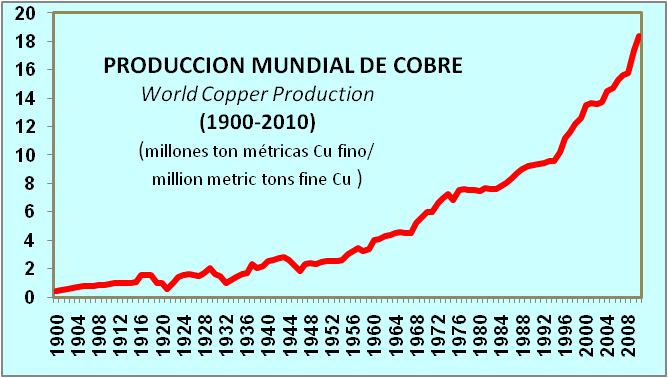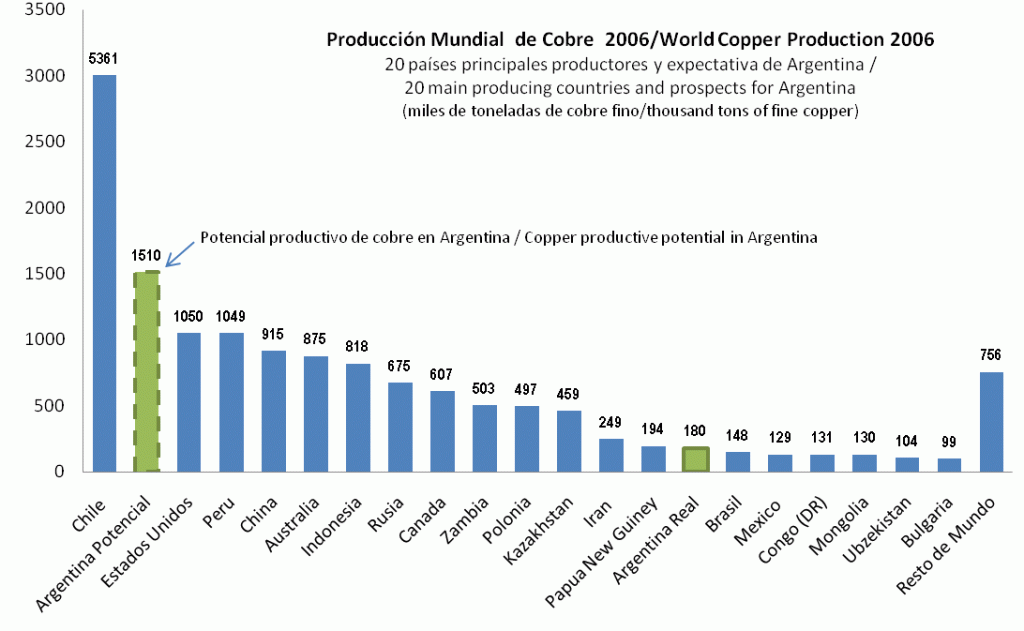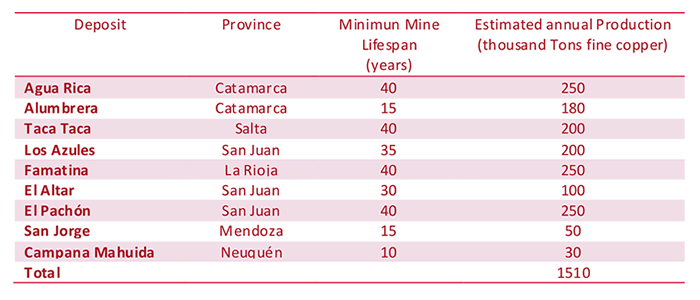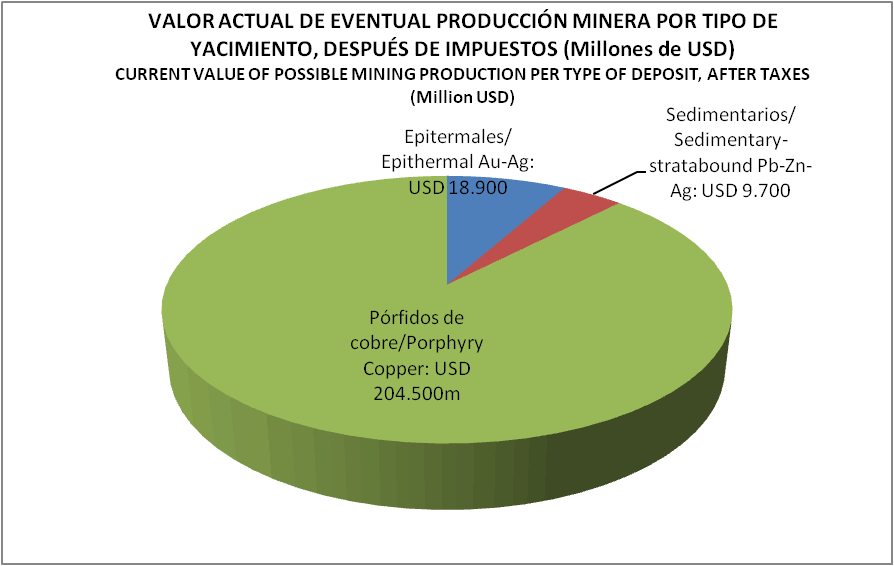In the last edition of the Argentina Mining Convention, Nivaldo Rojas, President of Rojas & Asociados Mining Consultants, made a detailed analysis of the possibilities and opportunities existing in Argentina for copper mining development. Just to give an idea, 14 ore deposits could be producing in Argentina, within a period of 5 to 10 years, and would generate over 332,000 M dollars. This amount would position the country as an important player in the industry compared to the US and Peru.
“Twenty years ago, Argentina was a country with a limited metalliferous production. The only mines were practically El Aguilar Mine and Farallón Negro, which produced small amounts of silver, lead, zinc, and gold. Amendments in mining laws introduced since then have enabled the identification of new ore deposits, the exploitation of 11 metalliferous mines, and the identification of mineral resources of various categories in 30 additional projects. Nowadays, Argentina is positioned among copper (14º), gold (13º), silver (12º), and zinc (26º) producers. This article is aimed at comparing copper mineralization with other metalliferous resources, based on available public data,” Rojas explains.
The steady increase in copper demand is mainly due to its physicochemical characteristics, its relative abundance in the earth crust, the relationship price/use, the technological advancements, and worldwide population growth. The red metal used in the industry comes from ore deposits and the recycling of copper-made instruments. In this case, Rojas focuses on copper produced by the extractive industry, or primary copper, which is of vital importance to satisfy growing global demand. In domestic terms, we will discuss the significance of copper in the Argentinean mining industry.
“From 1900, when copper starts being used industrially, its production reached 400 thousand tons/year. Then, it shows a general sustained growth which rises up to 18 million tons toward the year 2010, registering variations caused by war/postwar effects, major crisis, and periods of economic slowdowns,” contextualizes Nivaldo.
Primary production sources
 Primary Copper production sources can be divided into the following areas: Porphyries from Chile- Argentina-Peru-Ecuador; porphyries from USA-Central America (BC, AR, CAL, SONORA, PR, RD, PA, NI); porphyries from the Philippines, Indonesia, Papua New Guinea, West of Australia, New Zealand; porphyries from China-Mongolia, Kazakhstan, the Middle East, Central Europe; Kufferschieffer sediments (Germany-Poland); the Katanga copper belt in the Democratic Republic of Congo and Zambia and, finally, IOCG types (iron ore, copper and gold deposits) in Australia, Chile and Peru.
Primary Copper production sources can be divided into the following areas: Porphyries from Chile- Argentina-Peru-Ecuador; porphyries from USA-Central America (BC, AR, CAL, SONORA, PR, RD, PA, NI); porphyries from the Philippines, Indonesia, Papua New Guinea, West of Australia, New Zealand; porphyries from China-Mongolia, Kazakhstan, the Middle East, Central Europe; Kufferschieffer sediments (Germany-Poland); the Katanga copper belt in the Democratic Republic of Congo and Zambia and, finally, IOCG types (iron ore, copper and gold deposits) in Australia, Chile and Peru.
According to Rojas, copper resources are finite and the balance between growing demand and production depends on the continuous replacement of mineral resources. This requires the use of new technologies in exploration and in metal production, concentration, refining, and distribution processes. Besides, a constant reduction in the amount of metal contained in ore deposits (grade) is evidenced, what entails an extensive search of mineral deposit in new geographic frontiers.
Moreover, the analyst explains that, “copper porphyries, or disseminated copper, characterized by low mineral grades (0.2-1% Cu) and high volumes (hundreds of thousands and sometimes several billions of tons of mineralized rock) produce around 70% of worldwide copper, apart from other significant by-products such as gold, molybdenum, and silver. ”
A global viewpoint
Consultant and copper world market analyst, Alfonso González, who was also a lecturer at Argentina Mining 2010, stated that short-term projections for the refined copper world market point at a balance or a mild oversupply until the first quarter of 2011. However, Mr. González considers a major copper price decline to be unlikely in the following months and states that, “international investment funds will tend to buy copper positions during price weakening periods, before the market tightening forecasted to take place in the medium term. ”
Alfonso González also considers that a strong copper demand in China and worldwide economic recovery outside China since 2011 onwards, together with the postponement of copper mining projects due to the low copper prices in 2008/2009 will cause the refined copper global market to go into deficit in 2011 and 2012, with refined copper stocks registering a significant decline and copper price recovering in 2011 and subsequent years, thus exceeding the 400 c/lb level toward 2013.
According to his analysis, the copper world industry could be facing a new oversupply and price decline cycle starting in 2017 on account of a great many large mining projects which could be simultaneously operating around the world in that year.
The outlook for the concentrate market points at a deep and long global deficit in 2010 and subsequent years, with low copper treatment and refining charges (TCRCs) until 2013. González anticipates that this situation could only be lessened or reverted towards the end of 2013 thanks to the start-up of new large-scale copper mining projects producing copper concentrates.
The situation in Argentina
 The potential of copper deposits in Argentina is well known since the 60’s and it occurs in a highly favourable geological environment. In 1997, Argentina positioned itself among the copper producers thanks to Bajo de la Alumbrera, and other ore deposits are confirmed such as San Jorge, Taca Taca, El Altar, Campana Mahuida, Los Azules, El Pachón, Famatina, José María, and Agua Rica, among others. Despite ten gold and silver mines operating today, no copper mines have been opened since Alumbrera.
The potential of copper deposits in Argentina is well known since the 60’s and it occurs in a highly favourable geological environment. In 1997, Argentina positioned itself among the copper producers thanks to Bajo de la Alumbrera, and other ore deposits are confirmed such as San Jorge, Taca Taca, El Altar, Campana Mahuida, Los Azules, El Pachón, Famatina, José María, and Agua Rica, among others. Despite ten gold and silver mines operating today, no copper mines have been opened since Alumbrera.
The region with the largest known copper resources is by far the Central Andes (Chile, Peru, Argentina, Bolivia), region that contributes with about 40% of the total copper consumed in the world. Chile, with a well-defined mining policy, produces 30% and Peru, another mining country, is the world’s third largest copper producer with 1.2 million tons/year.
 Argentina, with only one operating mine and in the 14th position, produces concentrates containing 180 thousand tons of fine copper and 600,000 ounces of gold (2009). It is a paradox that even though copper deposits have been identified since 1960 and Alumbrera has been in operation since 1997, no new copper mines have been built. However, several first-rate copper-bearing deposits have been discovered and outlined. The efforts made by several companies during the last 15-20 years have allowed the delineation of copper projects with present data, potential resources, and infrastructural possibilities to be operating in the short term.
Argentina, with only one operating mine and in the 14th position, produces concentrates containing 180 thousand tons of fine copper and 600,000 ounces of gold (2009). It is a paradox that even though copper deposits have been identified since 1960 and Alumbrera has been in operation since 1997, no new copper mines have been built. However, several first-rate copper-bearing deposits have been discovered and outlined. The efforts made by several companies during the last 15-20 years have allowed the delineation of copper projects with present data, potential resources, and infrastructural possibilities to be operating in the short term.
“If these projects evolved into mines, the Argentinean copper production could reach USA’s and Peru’s production levels, thus positioning among the five largest copper producers,” says Rojas with hope.
 In this way, and just to mention a figure, we may predict that the 14 ore deposits that could be operating in Argentina within a period of 5 to 10 years would generate over 332,000 M dollars. This amount would position the country as an important player in the industry at the scale of USA and Peru.
In this way, and just to mention a figure, we may predict that the 14 ore deposits that could be operating in Argentina within a period of 5 to 10 years would generate over 332,000 M dollars. This amount would position the country as an important player in the industry at the scale of USA and Peru.
“The by-products recovered during the processes (gold, silver and molybdenum) contribute to raise the value of products. In a simple analysis of the resources, price and costs of the three main geological types of ore deposits, the economic resources obtained from copper clearly surpass gold-silver epithermal deposits and lead-zinc-silver stratiform deposits,” sums up Nivaldo.
Expectations on significant copper resources in Argentina attract investors, though not a single copper mine was built since 1997. Why, then, doesn’t Argentina produce more, considering its large copper deposits?
The answer lies in high taxes, provincial obstacles to mining, difficulties in obtaining the social license, high investments, and few Argentinean companies involved in high-risk projects.
To conclude, Rojas analyzes that “it is clear that today copper is the most favourable product for the Argentinean mining development in the medium term. Nevertheless, precious metals, which involve shorter periods of returns and lower initial investments, among other factors, have attracted most investments. The final message is clear: If Argentina wishes to include mining in its economic productive scene, it must provide the conditions that contribute to the development of copper deposits.”
It is true that today Argentina cannot compare with Chile’s reserves and resources. But it could compete with the US, Peru, and China. The development of the Argentinean copper, a golden opportunity –if an analogy with its metal colleague is allowed- for our country, depends on the Government, the companies’ decisions, and financing capabilities.